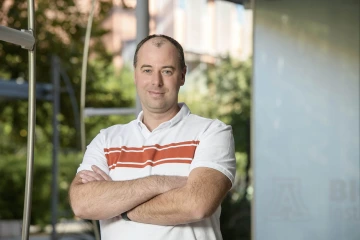Learn More About Dr. Purdy’s Research

John Purdy, PhD.
John Purdy, PhD, assistant professor of immunobiology at the University of Arizona College of Medicine – Tucson and member of the BIO5 Institute, peers into the private lives of viruses, watching them hijack our cellular machinery to pump out the previously undiscovered raw materials necessary for their replication.
The virus peering back at him from the other side of the microscope is human cytomegalovirus, or CMV. Although it’s not a well-known virus, more than half of U.S. adults are infected with CMV by the time they reach 40.
“Even though most of us are infected, we potentially live our whole life with this virus and never know it, as long as we have a healthy immune system,” Dr. Purdy said. “But every once in a while, it reactivates from a dormant state. If the immune system fails to keep the virus in check, then it goes haywire and can replicate in great quantities, and can cause disease, including death.”
In individuals whose immune systems aren’t firing on all cylinders — they may be too young, too old, pregnant, in treatment for cancer or an organ transplant, living with HIV or otherwise immunocompromised — a normally innocuous CMV infection might become a serious concern. In these instances, there are drugs to treat CMV, but Dr. Purdy says they come with negative side effects and spur drug resistance.
Additionally, as one of the few pathogens that can cross the placenta, CMV poses a threat during pregnancy, increasing risk of birth defects such as hearing loss. With better drugs, affected newborns’ hearing could potentially be preserved.
“Say a newborn has 20% hearing loss from a CMV infection,” Dr. Purdy said. “Typically, the hearing loss will get worse, and they may have 90% hearing loss by one year of age. If we can treat those newborns, we might prevent further hearing loss.”
Solving mysteries
When Dr. Purdy came to the University of Arizona Health Sciences in 2015, he already had discovered that CMV triggers the elongation of fatty acids, the hydrocarbon chains that form the tails of lipids. He hoped to learn more about these fatty acids and what they did.
“We were trying to follow what the virus was telling us to follow,” he said. “It kept telling us to look at fatty acids and lipids.”
Once at Health Sciences, he developed the rare ability to identify and measure these lipids in infected cells, uncovering more of CMV’s secrets.
“We’re seeing lipids that nobody else is able to see,” he said. “I don’t think there’s any other lab doing it the way we are.”
Dr. Purdy learned the virus uses these lipids to “remodel” the membranes of infected cells. After replicating, new viruses cloak themselves in bits of the remodeled membrane before leaving the host cell to infect neighboring cells. He hopes that someday a drug will inhibit the body’s ability to make these lipids, depriving CMV of its cloak — without which it is unable to be infectious.
To reach that goal, scientists need a solid understanding of the cascade of events that allow a virus to replicate, like a row of dominoes tumbling upon one another in succession. With that information, they can design a drug that removes a domino from the lineup, stopping viral replication in its tracks.
“If a drug blocked the synthesis of these lipids, it would be a dead end for that virus,” Dr. Purdy said.

